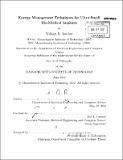Energy management techniques for ultra-small bio-medical implants
Author(s)
Sanchez, William R
DownloadFull printable version (22.29Mb)
Other Contributors
Massachusetts Institute of Technology. Dept. of Electrical Engineering and Computer Science.
Advisor
Joel L. Dawson.
Terms of use
Metadata
Show full item recordAbstract
Trends in the medical industry have created a growing demand for implantable medical devices. In particular, the need to provide medical professionals a means to continuously monitor bio-markers over long time scales with increased precision is paramount to efficient healthcare. To make medical implants more attractive, there is a need to reduce their size and power consumption. Small medical implants would allow for less invasive procedures and greater comfort for patients. The two primary limitations to the size of small medical implants are the batteries that provide energy to circuit and sensor components, and the antennas that enable wireless communication to terminals outside of the body. In this work we present energy management and low-power techniques to help solve the engineering challenges posed by using ultracapacitors for energy storage. A major problem with using any capacitor as an energy source is the fact that its voltage drops rapidly with decreasing charge. This leaves the circuit to cope with a large supply variation and can lead to energy being left on the capacitor when its voltage gets too low to supply a sufficient supply voltage for operation. Rather than use a single ultracapacitor, we demonstrate higher energy utilization by splitting a single capacitor into an array of capacitors that are progressively reconfigured as energy is drawn out. An energy management IC fabricated in 180-nm CMOS implements a stacking procedure that allows for more than 98% of the initial energy stored in the ultracapacitors to be removed before the output voltage drops unsuitably low for circuit operation. The second part of this work develops techniques for wide-input-range energy management. The first chip implementing stacking suffered an efficiency penalty by using a switchedcapacitor voltage regulator with only a single conversion ratio. In a second implementation, we introduce a better solution that preserves efficiency performance by using a multiple conversion ratio switched-capacitor voltage regulator. At any given input voltage from an ultracapcitor array, the switched-capacitor voltage regulator is configured to maximize efficiency. Fabricated in a 180-nm CMOS process, the chip achieves a peak efficiency of 90% and the efficiency does not fall below 70% for input voltages between 1.25 and 3 V.
Description
Thesis (Ph. D.)--Massachusetts Institute of Technology, Dept. of Electrical Engineering and Computer Science, 2012. Cataloged from PDF version of thesis. Includes bibliographical references (p. 167-174).
Date issued
2012Department
Massachusetts Institute of Technology. Department of Electrical Engineering and Computer SciencePublisher
Massachusetts Institute of Technology
Keywords
Electrical Engineering and Computer Science.